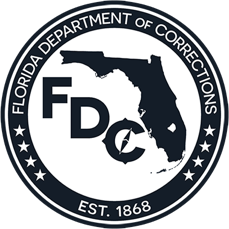1981
INMATE POPULATION JUNE 30, 1981: 21,575
The legislature establishes Prison Rehabilitative Industries and Diversified Enterprises (PRIDE), a non-profit corporation that trains inmates and provides them with marketable and accredited job skills as well as a job upon release.
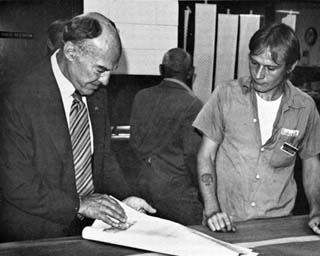
Jack Eckerd, Chairman of P.R.I.D.E., reviews a copy of the Correctional Compass in the collating department of the Zephyrhills C.I. print shop, which is now operated by P.R.I.D.E.
By June 30, 1981, the inmate population has grown from 19,692 the previous year to 21,575, a 9.6% increase.
Offender Based Information System (OBIS): New databases implemented this year include the Inmate Information System (batch mode only).
Tomoka Correctional Institution (Daytona Beach, FL) opens. Butler Transit Unit (Annex of Reception and Medical Center) is established.
HOSTAGE SITUATION AT UNION C.I.
On February 17 at approximately 3:40 p.m., two knife-wielding inmates at Union C.I. enter the outer office of the Assistant Superintendent and take two secretaries hostage. They demand to be released, given an automobile full of gas and a multiple channel radio. Both inmates are serving life terms. Jerry Rasberry is serving life plus 20 years for robberies and assault, and he is sentenced as a habitual offender. Ray Mitchell has four life sentences plus 40 years for the murders of four in Miami.
One of the secretaries is rescued within 15 minutes when Correctional Officer Dennis Dowling, Admin. Asst. J.T. Richardson and Col. Donald Jackson kick in the door of the office and yank her to safety. They are unaware of the second hostage until they hear her scream. Rasberry is holding a knife to her throat, which will continue throughout the ordeal.
Superintendent R.D. Massey, Asst. Supt. Paul Gunning and Inspector Ed Sands enter the office and begin face-to-face negotiations. The inmates decline Sands' offer to trade himself for the hostage. Rasberry and Mitchell are allowed to speak to various family members in the hours that follow. The Duval County Sheriff's Office Hostage Negotiation Team arrives to assist, as does its SWAT team. Little progress is made and the inmates remain adamant in their demands.
Approximately 10 hours after the hostage situation began and all other avenues have been explored, Supt. Massey and eight armed officers prepare to storm the office. The other officers involved were Lt. Raymond Wilkerson, Lt. Michael Rathmann, Colonel D.E. Jackson, Lt. Gene Griffis, Major G.L. Tomlinson, Sgt. John Newman, Sgt. R. Murrhee and Colonel Tom Barton. All but Barton work at Union C.I. - Barton works at neighboring Florida State Prison and is known for his accurate marksmanship and calm under pressure. The previous year he ended a hostage standoff with one shot from a 12-gauge shotgun. All the officers are later commended by the grand jury for their actions.
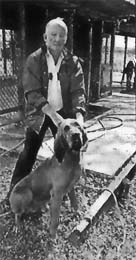
Enoch "Gene" Griffis, who concealed a two-shot Derringer in his tobacco pouch, effectively ended the standoff by shooting both inmates.
Lt. Griffis, who knows Rasberry from his work detail, has been serving as a go-between during the day. He would relay messages and demands from the inmates to the superintendent and back. Though as Griffis put it, "You could have had the governor in there and we still wouldn't let you go." The plan is for Lt. Griffis to enter the room alone, armed with the Superintendent's two shot derringer hidden in his Red Man tobacco pouch. Griffis is to fire his derringer at the inmate holding the hostage if a clear shot can be made, and that shot would trigger the others to come in both doorways. (A derringer is an unusual weapon, but was chosen for its small size so that it could be concealed easily.)
According to an article in the Miami Herald by Michael Browning, this is what happened next:
"Rasberry was distracted - he was on the phone with his mother in Tampa. Griffis set the tobacco pouch on a desk, reached in, grabbed the derringer and fired at Mitchell, who lunged forward and fell, dying. Griffis turned and fired into Rasberry's chest. It entered below the heart, severing an artery. Rasberry fell and grabbed the hostage, who was frantically trying to crawl under a desk. There was a tremendous blast as Colonel Tom Barton blew the lock off the office door with a shotgun and burst in. Another officer, Gene Tomlinson, followed, firing five more shots into the struggling Rasberry, who finally released the hostage, though not without cutting her superficially across the neck and shoulder."
Mitchell had been shot three times in the chest and was pronounced dead at 1:28 a.m. Incredibly, Rasberry survived. He later died in prison on January 5, 2000. The plan succeeded in freeing the hostage. The stab wound she sustained during the melee required numerous stitches.
According to a grand jury investigation into the shooting, which was found justifiable:
"The Grand Jury commends most highly the patience and courage of Raymond Massey and his staff for the professional manner in which they handled this most explosive situation. The Grand Jury specifically commends H. Edward Sands for his attempt to substitute himself for (the hostage), knowing the personal danger that this might entail. The Grand Jury further commends Officers Enoch Eugene Griffis, Tom Barton and Gene Louis Tomlinson for the professional manner in which they carried out their assignments."
Also commended were both hostages "...in their position as public servants for enduring a most harrowing experience with courage and calmness..."
Less than two months later, Union Correctional Institution (UCI) would find itself involved with another hostage situation, with equally grave results.
THREE UCI INMATES ESCAPE,
ONE KILLS OFFICER, CIVILIAN
In the middle of the night (2:20 a.m.) on April 11, three Union C.I. inmates overpower a correctional officer and bound and gag him before shoving him into a cell. They steal his watch, wallet and keys while threatening to kill him and choking him to near unconsciousness. They escape their building, dig up a set of wire cutters and other escape paraphernalia and cut through the inner and middle perimeter fences. Scaling the outer perimeter fence, they flee into a wooded area behind the institution. As it is extremely foggy that night, an officer has been posted on Fog Patrol and he hears noises and sees one of the inmates disappearing into the dark woods. He fires one round in the direction of the escape suspect(s). The escaping inmates are James Malone, 26; Edward Kennedy, 35; and James Bonaventura, 27. All three are serving life sentences for murder.
Canine officers Sgt. William B. Jackson and Correctional Officer Duane Jordan apprehend escapees Malone and Bonaventura at 6:19 a.m.; they had been free for almost four hours. They had made it 12 miles from the institution. Kennedy has split off from the others and is using evasive maneuvers so that the dogs will lose his track. As is routine in any escape, all local law enforcement were notified and have joined in the search.
At 2:30 p.m., Union C.I.'s control room gets word that a shooting has occurred in the nearby Baldwin area. Dept. of Corrections Sgt. R. Walmsley and Officer R. Watson, who were on patrol in that area looking for Kennedy, are advised by a Florida Highway Trooper to follow him. Upon arriving at the scene near some mobile homes, both officers hear several gunshots and see three or four troopers chasing someone who matches Kennedy's description. Sgt. Walmsley joins the troopers in their pursuit.
Officer Watson hears a trooper request assistance and sees another trooper and a civilian laying on the ground, apparently injured. Watson assists in administering first aid to the wounded trooper. Florida Highway Patrol Officer Robert P. McDermon, age 36, dies at the scene from his injuries. Watson and the trooper also attempt to assist Floyd Hartford Cone, Jr., 32, who also dies from his injuries. Both had been shot to death.
Meanwhile, Sgt. Walmsley verifies that the man they are chasing is escaped inmate Kennedy. By this time, Kennedy has taken a woman and seven-month-old child hostage. He tells his pursuers: "If ya'll come any closer, I'll kill her." They attempt to persuade Kennedy to release the hostages, but he refuses, backing up with the two hostages into a mobile home via the front door. The Highway Patrol begins negotiations. Kennedy requests the presence of Channel 12 in Jacksonville before he will release the hostages and put down his weapon. Channel 12 is notified and responds to the scene. At 3:50 p.m. Kennedy releases the hostages unharmed, surrenders to the Florida Highway Patrol and is taken to the Duval County Jail.
Kennedy is executed at Florida State Prison on July 21, 1992 for the murders of Florida Highway Patrol Officer Robert P. McDermon and Floyd H. Cone, Jr.
Just as the inmates were said to have "escape fever" in the late 1970s, it appears to have returned in 1981. In fact, three of the inmates who had escaped in 1978 were at it again in 1981. Laymen might ask why, if an inmate is an escape risk, they were able to breach security more than once. Florida State Prison (FSP) is one of the prisons where escape risks are sent, because of its maximum security level. That is where these individuals escaped from. As one officer put it, "We have eight hours a day to watch these inmates, and they have 24 hours a day to figure out how to escape." Often they steal utensils from the kitchens or their work areas, sharpen them, hide them, then use them to cut fences or dig tunnels when the opportunity presents itself. In addition, you have to consider the conditions in prison at the time. Cells were overcrowded, prison admissions were increasing, many of the officers were new and inexperienced. But with each escape, administrators learned new ways to stop it from happening again, and security would tighten. Today, escapes from the perimeter of a prison are extremely rare, even though the inmate population has increased a great deal since 1981.
FIVE INMATES ESCAPE FROM FSP, FOUR IMMEDIATELY RECAPTURED
On April 20, 1981, five FSP inmates with sentences ranging from seven years to life hid under a utility elevator in the kitchen area of the facility until about 3:10 p.m. They were Dennis Pickle, Ralph Magna, Louis Ayendes, Manuel Tallavera and Raymond Despres. At approximately 3:10 p.m., Magna changed into a Correctional Officer's uniform that had been concealed under the elevator. At 3:25 p.m., assuming the role of a CO, Magna escorted the other four inmates out of the kitchen area, through the industries gate and to the broom factory located in the garment factory building. There, they broke the exterior door lock, entered and secured the door with electrical wire.
Meanwhile, they were discovered missing and a search for them had begun. At about 8 p.m. the inmates exited the broom factory and proceeded to the perimeter fence, where they cut through. Five minutes later Officer Mock noticed movement at the cross fence and advised the control room. He then saw the inmates exiting the fence and fired a total of four rounds from a 12 gauge shotgun and four rounds from another gun. Another officer also fired, but his gun jammed. Escape and recapture plans were put into effect, including notifying the sheriff's office in Bradford County and the local community. Institutional staff in the area also assisted. Four and a half hours later, inmate Magna was apprehended in a wooded area near Highway 16. At 5:50 the next morning, Tallavera and Ayendes were recaptured in a wooded area west of the prison. The next day, both Pickle and Despres were also recaptured.
Despres died April 17, 2003 in prison and Manuel Tallavera died in prison on July 12, 2018. Dennis Pickle was paroled May 19, 1992, Louis Ayendes’ sentence expired on February 8, 1990 and Ralph Magna was still in prison in May 2023.
August, 1981 - Miami, Florida. Florida State Prison and Union Correctional Institution are awarded accreditation. All 24 major institutions named in the April, 1979 contract are now accredited. On the same day Lancaster Correctional Institution also passes its audit. All major institutions in the Florida Department of Corrections are either fully accredited, or have passed an audit and will receive full accreditation.
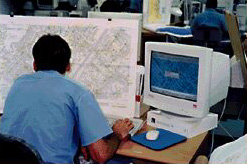
Inmate attending computer class to learn C.A.D. systems.
COMPUTERS AND CORRECTIONS
Paul Maurer, who retired April 28, 2006 after 32 years with the Department of Corrections (including two years with the Parole Commission), remembers laying under a desk in former Secretary Louie L. Wainwright’s office installing software on a server that connected old terminals to the mainframe computer while Wainwright explained to a visitor the purpose of a computer. He also fondly remembers former Secretary Harry K. Singletary, Jr.’s grasp of what computers could do for the department, and how respectful he was of Information Technology (IT) and the people who work in the IT field.
“IT really cranked up under Harry,” said Maurer, citing the introduction of the cashless canteen for inmates, the court ordered payment system (COPS) for probation payments, and the Computer Assisted Reception Process (CARP) as examples. He also notes FDC’s national reputation for innovation. “Our system is one of the most respected and emulated criminal justice computer systems in the country.”

Paul Maurer
By the early 2010s, FDC’s IT office processes more than four million transactions (the number of times an ‘enter’ key is hit) a day and over 5,000 batch reports that print around the clock. Programming staff maintains over 500 online screens; and over 1,500 batch programs are constantly in use by users on 15,000 personal computers scattered throughout the state. Today, the FDC system is accessible 24 hours a day, seven days a week.
Maurer participated in a seminal moment in the history of the Department of Corrections. He was there in the early 1980s when the process of counting inmates changed over from hand counting the number of inmates in the system to keeping track of them via computer.
Maurer, who retired as Assistant Data Center Director, recalls being in a meeting around 1981 with, among others, former Deputy Secretary Dave Bachman, Special Assistant to the Secretary T.P. Jones and Assistant Secretary for Operations Paul Skelton. He had been called into the meeting (or “thrown to the wolves,” as he put it) because upper management staff wanted to know why the computer totals and hand-count totals of the inmate population were not equal. Everyone assumed the computer totals were wrong, because the technology was new. Maurer said he’d find out, so he called every institution that had a discrepancy between what the Officer in Charge had reported was the inmate count total and what the computer told them it was. What he learned was that, in every case, the computer number was correct. This was for a variety of legitimate reasons, such as an inmate who was there for the hand count was later transferred out to court, or because officers simply miscounted a specific dorm. But the bottom line was that, for the first time in FDC history, the computer kept more accurate, up-to-date records than humans.
“From that day forward, IT was seen as a force in the running of the department. That particular moment was one of the big turning points that led to our doing heavy-duty online movement of inmates,” said Maurer.
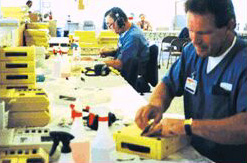
Tomoka inmates working with audio tapes

Inmate sharpens her sewing skills
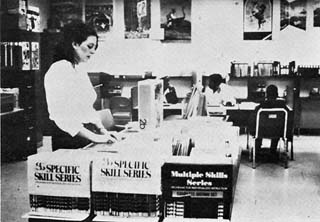
Inmate using reading material at one of the department's many institutional libraries.
- 1821-1845
- 1868-1876
- 1877-1895
- 1900-1919
- 1921
- 1922-1924
- 1927
- 1928-1931
- 1932 | CHAPMAN
- 1933-1935
- 1936-1939
- 1940-1945
- 1946-1949
- 1950-1955
- 1956-1961
- 1962 | WAINWRIGHT
- 1963-1965
- 1966-1969
- 1970-1975
- 1976-1979
- 1980-1986
- 1987 | DUGGER
- 1988-1990
- 1991 | SINGLETARY
- 1992-1995
- 1996-1998
- 1999 | MOORE
- 2000-2002
- 2003 | CROSBY
- 2004-2005
- 2006 | MCDONOUGH
- 2007
- 2008 | MCNEIL
- 2009-2010
- 2011 | BUSS
- 2011 | TUCKER
- 2012 | CREWS
- 2013-2014
- 2014 | JONES
- 2015-2018
- 2019 | INCH
- 2020-2021
- 2021 | DIXON
- 2022-Today
- Population Summary Table

